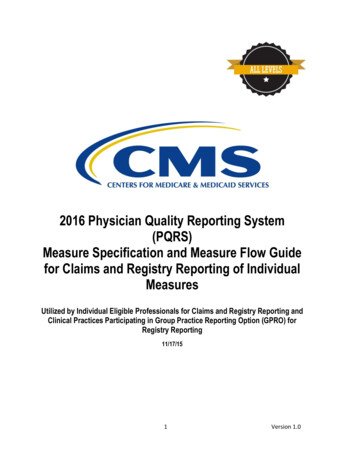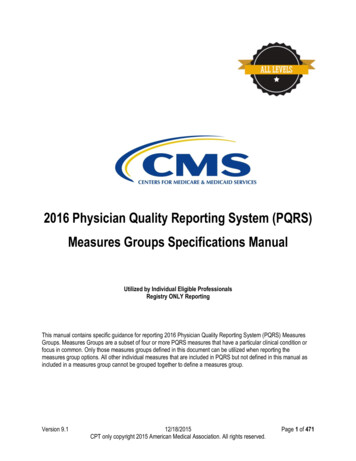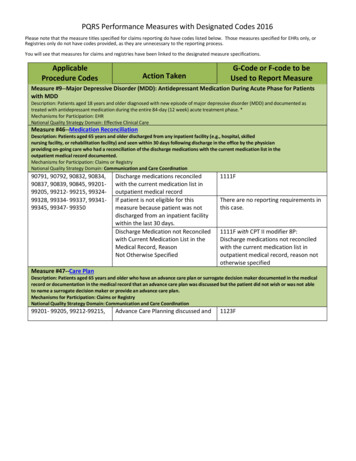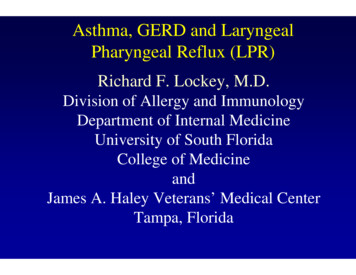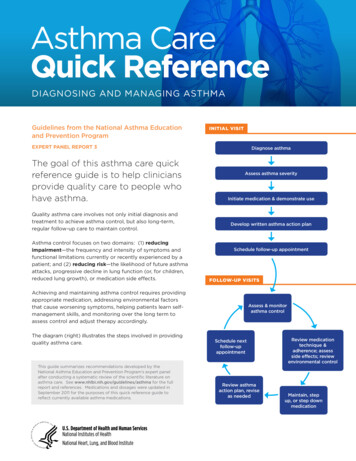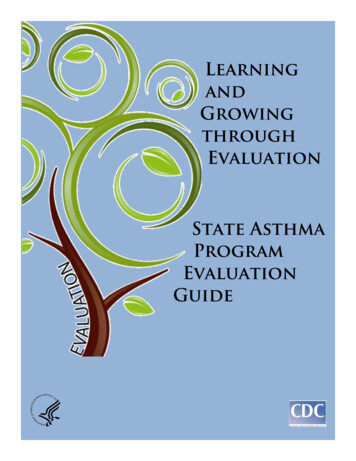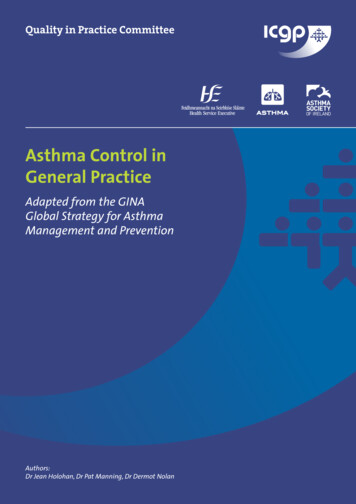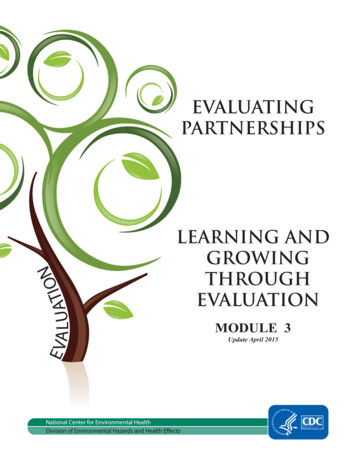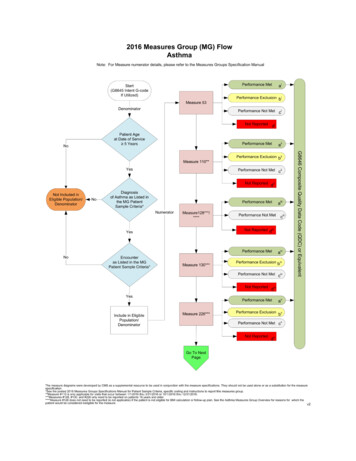
Transcription
2016 Measures Group (MG) FlowAsthmaPlease refer to the specific section of the 2016 PQRS Measures Groups Specifications Manual to identify specificcoding and instructions to report the Asthma Measures Group Patient Sample Criteria (denominator), individualmeasures, and numerator options information for use in reporting this Measures Group.1. Start with G8645 Intent G-code if Utilized2. Check Patient Age:a. If the Age is greater than or equal to 5 years of age at Date of Service equals No, do not include inEligible Population/Denominator. Stop Processing.b. If the Age is greater than or equal to 5 years of age at Date of Services equals Yes, proceed to checkPatient Diagnosis.3. Check Patient Diagnosis:a. If Diagnosis of Asthma as Listed in the MG Patient Sample Criteria equals No, do not include in EligiblePopulation/Denominator. Stop Processing.b. If Diagnosis of Asthma as Listed in the MG Patient Sample Criteria equals Yes, proceed to checkEncounter Performed.4. Check Encounter Performed:a. If Encounter as Listed in the MG Patient Sample Criteria equals No, do not include in EligiblePopulation. Stop Processing.b. If Encounter as Listed in the MG Patient Sample Criteria equals Yes, include in the EligiblePopulation/Denominator.5. Denominator Populationa. Include in Eligible Population/Denominator is all eligible patients who meet the Patient Sample Criteria(denominator) for the Measures Group. For each measure within the measures group each numeratoroption is represented by a letter which is used in the Scenarios for Reporting and PerformanceAlgorithms at the end of this document.6. Start Numerator Options for Measures within the Measures Group7. Composite Quality Data Code (QDC) G8646 has been created for registries that utilize claims data. ThisQDC may be reported in lieu of individual QDCs when all quality clinical actions for all applicable measureswithin the group have been performed for this patient.8. Measure 53a. Numerator option Performance Met has an arrow pointing to G8646 Composite Quality Data Code(QDC) or Equivalent. Performance Met is represented by letter ai.b. Numerator option Performance Exclusion is represented by letter bi.c. Numerator option Performance Not Met is represented by letter ci.
d. Numerator option Not Reported is represented by letter di.9. Measure 110a. Measure #110 is only applicable for visits between 1/1/2016 thru 3/31/2016 or 10/1/2016 thru12/31/2016. When measure #110 is Not Applicable it is represented by letter eii in the Scenarios forReporting Algorithms.b. Numerator option Performance Met has an arrow pointing to G8646 Composite Quality Data Code(QDC) or Equivalent. Performance Met is represented by letter aii.c. Numerator option Performance Exclusion is represented by letter bii.d. Numerator option Performance Not Met is represented by letter cii.e. Numerator option Not Reported is represented by letter dii.10. Measure 128a. Measure #128 only needs to be reported on patients 18 years and older. Measure #128 does not needto be reported (is not applicable) if the patient is not eligible for BMI calculation or follow-up plan. Seethe Asthma Measures Group Overview for reasons for which the patient would be considered ineligiblefor the measure. When measure #128 is Not Applicable it is represented by letter eiii in the Scenariosfor Reporting Algorithms.b. Numerator option Performance Met has an arrow pointing to G8646 Composite Quality Data Code(QDC) or Equivalent. Performance Met is represented by letter aiii.c. Numerator option Performance Not Met is represented by letter ciii.d. Numerator option Not Reported is represented by letter diii.11. Measure 130a. Measure #130 only needs to be reported on patients 18 years and older. When measure #130 is NotApplicable it is represented by letter eiv in the Scenarios for Reporting Algorithms.b. Numerator option Performance Met has an arrow pointing to G8646 Composite Quality Data Code(QDC) or Equivalent. Performance Met is represented by letter aiv.c. Numerator option Performance Exclusion is represented by letter biv.d. Numerator option Performance Not Met is represented by letter civ.e. Numerator option Not Reported is represented by letter div.12. Measure 226a. Measure #226 only needs to be reported on patients 18 years and older. When measure #226 is NotApplicable it is represented by letter ev in the Scenarios for Reporting Algorithms.b. Numerator option Performance Met has an arrow pointing to G8646 Composite Quality Data Code(QDC) or Equivalent. Performance Met is represented by letter av.c. Numerator option Performance Exclusion is represented by letter bv.
d. Numerator option Performance Not Met is represented by letter cv.e. Numerator option Not Reported is represented by letter dv.13. Measure 402a. Measure #402 only needs to be reported on patients age 12-20 years of age. When measure #402 isNot Applicable it is represented by letter evi in the Scenarios for Reporting Algorithms.b. Numerator option Performance Met has an arrow pointing to G8646 Composite Quality Data Code(QDC) or Equivalent. Performance Met is represented by letter avi.c. Numerator option Performance Not Met is represented by letter cvi.d. Numerator option Not Reported is represented by letter dvi.14. Scenarios for Reporting and Performance Algorithms15. Patient X Age 25 Years Visit on 3/3/2016a. Patient X Met Measure 53 (represented by ai)b. Patient X Met Measure 110 (represented by aii)c. Patient X Met Measure 128 (represented by aiii)d. Patient X Met Measure 130 (represented by aiv)e. Patient X Met Measure 226 (represented by av)f.Patient X Not Applicable for Measure 402 (represented by evi)16. Patient Y Age 52 Years Visit on 10/9/2016a. Patient Y Met Measure 53 (represented by ai)b. Patient Y Not Met but Reported Measure 110 (represented by cii)c. Patient Y Not Met but Reported Measure 128 (represented by ciii)d. Patient Y Met Measure 130 (represented by aiv)e. Patient Y Exclusion Reported for Measure 226 (represented by bv)f.Patient Y Not Applicable for Measure 402 (represented by evi)17. Patient Z Age 13 Years Visit on 7/21/2016a. Patient Z did Not Report Measure 53 (represented by di)b. Patient Z Not Applicable for Measure 110 (represented by eii)c. Patient Z Not Applicable for Measure 128 (represented by eiii)d. Patient Z Not Applicable for Measure 130 (represented by eiv)
e. Patient Z Not Applicable for Measure 226 (represented by ev)f.Patient Z Met Measure 402 (represented by avi)18. Reporting Algorithma. Reporting of all applicable measures contained in the measures group, per eligible patient, equals oneb. Patient X Reporting equals 1 Plus Patient Y Reporting equals 1 Plus Patient Z Reporting equals 0 for atotal of 2 of the Required 20 Patient Sample Reported19. Performance Algorithms20. Measure 53a. Performance Met equals 2 divided by Reported QDC for 2 eligible patients minus 0 PerformanceExclusions equals 100% Performance Rate21. Measure 110a. Performance Met equals 1 divided by Reported QDC for 2 eligible patients minus 0 PerformanceExclusions equals 50% Performance Rate22. Measure 128a. Performance Met equals 1 divided by Reported QDC for 2 eligible patients equals 50% PerformanceRate23. Measure 130a. Performance Met equals 2 divided by Reported QDC for 2 eligible patients minus 0 PerformanceExclusions equals 100% Performance Rate24. Measure 226a. Performance Met equals 1 divided by Reported QDC for 2 eligible patients minus 1 PerformanceExclusion equals 100% Performance Rate25. Measure 402a. Performance Met equals 1 divided by Reported QDC for 1 eligible patient equals 100% PerformanceRate
11. Measure 130 a. Measure #130 only needs to be reported on patients 18 years and older. When measure #130 is Not Applicable it is represented by letter e. iv. in the Scenarios for Reporting Algorithms. b. Numerator option Performance Met has an arrow pointing to G8646 Composite Quality Data Code (QDC) or Equivalent.


